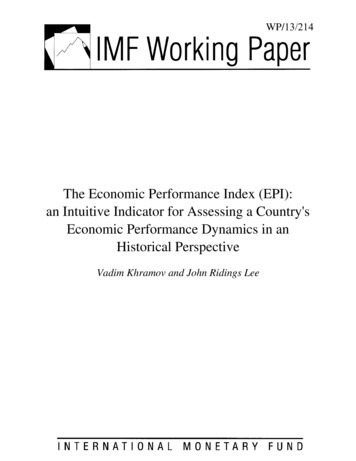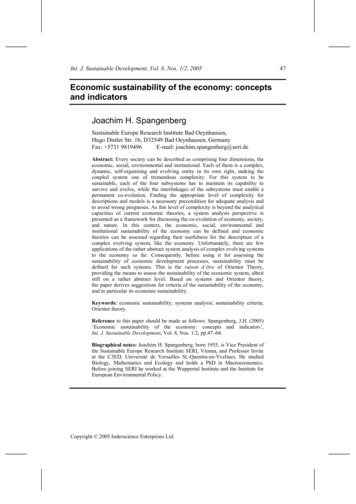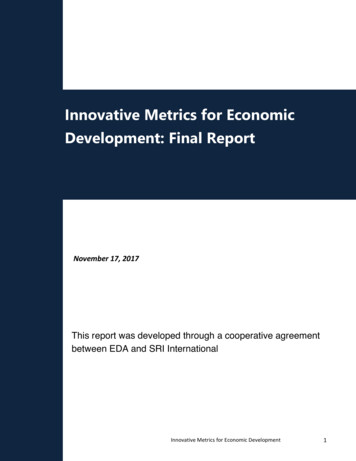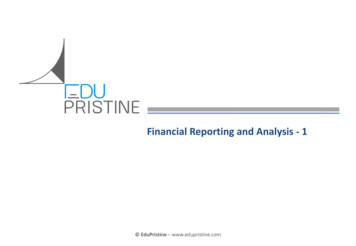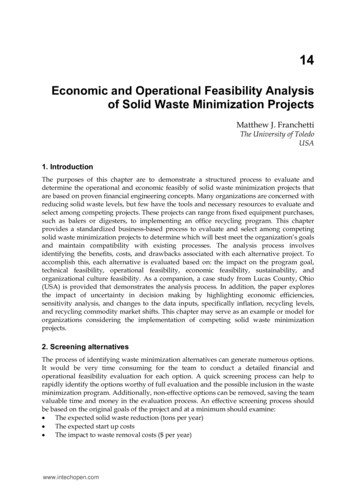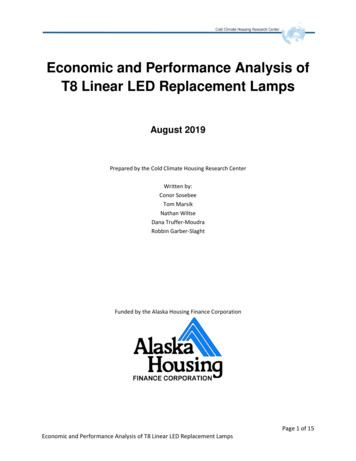
Transcription
Economic and Performance Analysis ofT8 Linear LED Replacement LampsAugust 2019Prepared by the Cold Climate Housing Research CenterWritten by:Conor SosebeeTom MarsikNathan WiltseDana Truffer-MoudraRobbin Garber-SlaghtFunded by the Alaska Housing Finance CorporationEconomic and Performance Analysis of T8 Linear LED Replacement LampsPage 1 of 15
Table of ContentsAbstract . 3Background information . 4Lamp Selection Methodology . 5Testing Methodology . 6Results and Discussion . 8Economics . 10Conclusions . 13Appendix . 14References . 15Disclaimer: The products were tested using the methodologies described in this report. CCHRC cautions that differentresults might be obtained using different test methodologies. CCHRC suggests caution in drawing inferences regarding theproducts beyond the circumstances described in this report.Economic and Performance Analysis of T8 Linear LED Replacement LampsPage 2 of 15
AbstractUpgrading from linear fluorescent lighting technology to linear LED lighting technology can presentfacility owners and operators with difficult decisions due to the sheer number of LED replacement options onthe market. Research staff at the Cold Climate Housing Research Center (CCHRC) conducted a brief literaturereview and market analysis to assemble a list of LED lamps meeting predetermined criteria. RepresentativeLED lamps from the list were selected for performance testing. The lamps were measured for power usageand illumination in a test room and monitored for incidences of 60Hz related flicker. Three lamps exhibitedillumination that was comparable to fluorescent lighting along with significant power savings. Additionally, aneconomic analysis was completed on LED replacement scenarios for UL Type B and UL Type A lamps in atypical public facility in Fairbanks, Alaska. A UL Type A LED lamp retrofit is the most cost-effective selectionwhen the ballasts are relatively new and compatible. A UL Type B LED lamp retrofit is the most cost-effectiveselection when the ballasts need to be replaced for any reason. Simple economic payback occurs within thewarranty period and rated life of LED lamps regardless of the LED replacement type selected.Keywords: LED, fluorescent, illumination, UL Type A, UL Type B, ballast compatible, line voltageEconomic and Performance Analysis of T8 Linear LED Replacement LampsPage 3 of 15
Background informationIn Alaska, over 5,000 publicly owned and leased facilities spend an estimated 641,245,000 annuallyon energy (Armstrong et al., 2012). Lighting accounts for approximately 9% of a public building’s totalenergy use yet accounts for an average of 18% of the overall energy cost or approximately 115,424,100(Wiltse, Madden, Valentine, 2014). Linear fluorescent lamps have a consistent track record, knownissues and labor components, and established manufacturers, which has led to their ubiquity in publicfacilities and private commercial buildings, especially T8 four-foot lamps.Light emitting diode (LED) lamps are more efficient than fluorescent lamps, thereby decreasinglighting costs in buildings where retrofits are implemented. LED technology has progressed rapidly andgained market share as the number of products and manufacturers has increased. However, buildingowners and operators are faced with a potentially difficult decision when it comes to retrofittingfluorescent lighting with direct replacements due to the vast number of options available on the market.There are different types of LED tube replacements that offer a one-to-one replacement: UL TypesA, B, and C. These lamp types are known as ballast compatible (A), ballast bypass or line voltage (B), andexternal driver (C), respectively. UL Type A replacement lamps contain an internal circuit that allows thelamp to be operated from a ballast. Ballast compatibility is critical to the successful operation of thesetypes of lamps and is dependent on the manufacturer; however, many newer ballasts tend to becompatible with LEDs. Lamp-only replacements can be done instead of ballast and lamp replacement ifrelatively new and compatible ballasts are already present in the facility. UL Type B replacement lampscontain an internal driver, function without the use of ballasts, and operate directly off of the facility’sline voltage. The UL Type B internalized electrical components in the tube can increase the likelihood ofa lamp failure compared to a UL Type A. Modifications of existing fixtures to house UL Type B lampsrequire visible documentation in the form of a sticker in the fixture. UL Type C replacement lamps havean external driver that powers the tube via low voltage and have more control options than types A andB. Modifying existing fixtures requires licensed electricians and adherence to manufacturer’sinstructions to maintain the UL listing of the fixture.The focus of this project was on the lowest cost solutions, and therefore, the emphasis of this reportis on Type A and B lamps. This report is intended to be a resource for facility owners, operators, andmaintenance personnel to help make informed decisions about lighting-related energy savings.This study is a follow-up to an initial study completed by the University of Alaska Fairbanks BristolBay Campus Sustainable Energy Program (Marsik, 2016). That report focused on UL Type A and Breplacement lamps for direct replacement. De-lamping and using higher-powered LEDs to achievedesired lumen outputs was not considered in this report as de-lamping is not always an option. Forrecommended illumination levels, consult the Illuminating Engineering Society’s (IES) Lighting Library(Illuminating Engineering Society, 2019).For this report, a brief market study was performed to determine which lamps are appropriatechoices for replacing fluorescent lamps. From that list, Cold Climate Housing Research Center (CCHRC)research staff selected 7 representative lamps identified in the market study for purchasing and testingin a dark room at the CCHRC Research and Testing Facility (RTF).Economic and Performance Analysis of T8 Linear LED Replacement LampsPage 4 of 15
Lamp Selection MethodologyCCHRC performed a brief market review to determine appropriate choices for replacing fluorescentlamps. This review entailed searching the LM-79 database, the DesignLights Consortium (DLC) database,and information directly from manufacturers. The LM-79 database, which is no longer available, hasmanufacturer independent performance data on over 7000 linear LED products. The DLC designateshigh performance products within the lighting industry. DLC certification is a typical requirement forenergy efficient rebate programs related to lighting. Several parameters were utilized to determine afinal list for this study from the myriad products: System power (not just bare lamp power) less than 17 watts (W) per lampMinimum 1500 manufacturer reported lumensUL listed for field installationRestriction of Hazardous Substances (RoHS) complianceLamp or product family has been third-party tested using the LM-79 procedureManufacturer with a substantial track record and at least a 5-year warrantyDesignLights Consortium (DLC) certificationAvailability and prevalence in AlaskaThe LM-79 test is performed on lighting products that are referred to as parent products. The testinginformation is then used to represent a greater set of products (e.g. different color temperatures).Parent lamps that met the above criteria were selected and compiled in a list that is available in theAppendix. A smaller list of representative lamps was selected for testing in order to expedite testing andmanage costs (Table 1).Table 1.Tested lamps. All of the tested lamps had a color temperature of 4000K.ManufacturerModelTypeReported lumensReported wattage(bare lamp)Philips10T8/48-4000 IF10/1 8E/840/12/F-79A190016GELED10ET8/G/4/840GE LAMP 34280 LEDA160010Philips12T8/PRO/48840/BB18/G 10/1 FBB180012Economic and Performance Analysis of T8 Linear LED Replacement LampsPage 5 of 15
t280032GEF32T8/SP30/ECOFluorescent280032The LED manufacturer reported luminous flux (the amount of light that can be perceived by humaneyes) with a normal ballast factor is much lower than the typical luminous flux for fluorescent lamps.Fluorescent lamps distribute light over 360 , which includes casting light into the fixture. Even thoughfluorescent lamps have a greater luminous flux, the directionality of the LED light allows a lower lumenoutput to equivalently illuminate a space.Testing MethodologyCCHRC research staff utilized a room in the RTF that had one luminaire and no windows to the exterior.The interior windows were covered to ensure that no other lighting would interfere with the testingluminaire (Figure 1).Figure 1. LED testing room at the RTF. The plywood is covering the interior window; it was taped in place to blockall light infiltration.Economic and Performance Analysis of T8 Linear LED Replacement LampsPage 6 of 15
The products selected from the market review summary were evaluated in-situ for the following: Measured system power in Watts (W)Measured illumination in foot-candles60 Hertz (Hz) related flickerEach test utilized four lamps. Two 2-lamp ballasts were used for the UL Type A and fluorescent tests.System power was analyzed through a Fluke 43B Power Quality Analyzer and a Kill A Watt P4400.01.Illumination was measured with a Sylvania DS-3050 Lightmeter. The 60Hz related flicker, which is theflicker from the lamp due to the 60Hz frequency of the electric grid, was evaluated with a cell phonecamera, which has a scan rate that interferes with the 60Hz related flicker and results in stripes (Figure2). The 60Hz flicker can produce adverse health effects, some of which can be extreme, such as epilepticseizures for photosensitive individuals. It is recommended, at a minimum, that lamps have flickermodulation less than 5% for limited effects (Lehman, 2015). This study did not measure flickermodulation.Figure 2. A cell-phone photograph may show horizontal stripes across the image from the 60Hz related flicker, as inthis case, exhibited by a UL Type B lamp. Flicker modulation was not measured in this study.Testing was performed with new Philips Advance Centium ICN-2P32-N ballasts for all of the ballastcompatible products (Figure 3). Initially, existing fluorescents (GE) with unknown age and usage historyfrom the RTF were evaluated. New fluorescent lamps (Satco) were burned in for 100 hours and thentested after the existing fluorescents. After the fluorescent lamp illumination baseline was established,testing proceeded for the LED replacements.Economic and Performance Analysis of T8 Linear LED Replacement LampsPage 7 of 15
Figure 3. Ballast used for testing UL Type A LED and fluorescent lamps. This ballast was indicated by themanufacturer to be compatible with a wide range of LED lamps.The testing luminaire is a 4-lamp recessed troffer. Each lamp test allowed at least 10 minutes forstabilization before measurements were taken. Illumination was measured with the light meter in 5locations per lamp test: 24” off the ground and directly below the luminaire69” and 93” off the ground on the luminaire’s long axis wall69” and 93” off the ground on the luminaire’s short axis wallResults and DiscussionAs shown in Figures 4 and 5, none of the tested LED lamps had higher illumination directly below theluminaire than a new fluorescent lamp. However, the Topaz, Philips 13T8, and Philips 16.5T8 lampsdemonstrated greater illumination below the luminaire than an older fluorescent lamp. The Philips 13T8and Philips 16.5T8 are designated high-output UL Type A and B models from that manufacturer’s line oflamps, respectively. The Topaz lamp was the only lamp that was not marketed as a high-output lampthat provided illumination greater than the older fluorescent. Lamps significantly lower in illuminationthan the old fluorescents (like the Philips 10T8) will not be adequate one-to-one replacements for thefluorescents unless there is a change in a room’s use or design foot-candle requirement.Economic and Performance Analysis of T8 Linear LED Replacement LampsPage 8 of 15
100Illumination 16.42015.51017.014.014.611.713.810.714.714.7 12.611.00Below luminaire(24")Short axis - 69"Short axis - 93"Long axis - 69"Long axis - 93"Light meter locationExisting fluorescent, 118.0 WPhilips 10T8, 51.4 WTopaz L4T8E, 67.8 WNew fluorescent, 117.0 WPhilips 13T8, 62.2 WGE 10ET8, 59.8 WFigure 4. Type A and fluorescent illumination comparison. The results of power and illumination measurements for thefluorescents and ballast compatible LEDs are in a 4-lamp, 2-ballast luminaire configuration.100Illumination .514.21014.611.417.014.712.211.90Below luminaire(24")Short axis - 69"Short axis - 93"Long axis - 69"Long axis - 93"Light meter locationExisting fluorescent, 118.0 WNew fluorescent, 117.0 WPhilips 16.5T8, 64.9 WSylvania 12T8, 46.4 WPhilips 12T8, 45.9 WFigure 5. Type B and fluorescent illumination comparison. The results of power and illumination measurements for thefluorescents and ballast bypass LEDs are in a 4-lamp, 2-ballast (fluorescent only) luminaire configuration.Economic and Performance Analysis of T8 Linear LED Replacement LampsPage 9 of 15
Table 2 shows the measured system power from the tested lamps. The UL type A lamps were measuredin conjunction with the Philips ICN-2P32-N ballast, which has a normal ballast factor of 0.88. The UL TypeB lamps are measured for lamp power only since they preclude the use of ballasts. All tested LED lampsdemonstrated considerable power reduction over the fluorescent lamps. The three lamps that had thehighest illumination, the Topaz, Philips 13T8, and Philips 16.5T8, had an average reduction of 45%compared to the fluorescent baseline.Table 2. LED Power Measurements and ComparisonManufacturerModelTypeSystem Power(W)System Power(W)/Lamp% e Philips 16.5T8 emitted an audible buzzing noise that was apparent to research staff. All of the ULType B lamps exhibited some 60Hz flicker. None of the UL Type A lamps demonstrated 60Hz flicker.EconomicsLED conversions from fluorescent lamps present ample opportunities to reduce the energy use ofbuildings. The economic payback calculation for an LED conversion includes maintenance schedules,lamp use, and labor in addition to the initial capital cost of the new materials. The following example,exhibited in Table 3, demonstrates the potential cost inputs and payback outcomes associated for apublic facility with 1000 lamps in Fairbanks, Alaska. These are the basic parameters: Electric rates utilize Golden Valley Electric Association’s (GVEA) GS (S/P) effective rate of 0.14per kWh and 21.62/KW demand charges.The reduction in power utilized by an LED compared to the fluorescent baseline uses theaverage reduction in power, 45%, from the three candidate lamps that provided the closest oneto-one illumination replacement.The LED lamps are priced at 10.00/lamp for either ballast compatible (Type A) or line voltage(Type B) lamps and 15.00/ballast for 2-lamp ballasts. The fluorescent lamps are 4.00/lamp.Prices for the lamps and ballasts can change depending on the volume purchased and discountsavailable to the purchaser from different manufacturers.Economic and Performance Analysis of T8 Linear LED Replacement LampsPage 10 of 15
The lamp usage rate used is 8 hours/day, which is the average lamp usage rate for 4’ T8 linearlamps in commercial facilities (Buccitelli et al., 2017).The labor rate is the prevailing rate for a licensed electrician in Fairbanks, AK of 100.00/hour. Alicensed electrician is presumed to perform the work in these scenarios.Scenario 1 presents a situation where the ballasts are still appropriate to continue using after achange-out from fluorescent lamps to LED lamps has occurred.Scenario 2 has the ballasts replaced for fluorescent relamping or a ballast compatible LED lampupgrade.The line voltage LEDs inputs for materials and labor remain the same irrespective of the ballastcondition.As shown in Table 3, any scenario with an LED retrofit provides a simple payback within the 5-yearwarranty period. An LED lamp’s rated life is typically about 50,000 hours, and at the average lamp usagerate for 4’ T8 linear lamps in commercial facilities would last for 17.3 years (Buccitelli et al., 2017). Thismeans the payback is much shorter than the life of the lamps. If the lamps are upgraded during anormal fluorescent re-lamping cycle then the cost of the normal re-lamping is deducted from the costsof the LED upgrade, thereby shortening the payback period. Conversely, if an LED retrofit is executedoutside of a normal maintenance cycle then the payback is extended but still favorable. The line voltageLED (UL Type B) upgrade shows a negative payback in Scenario 2’s simple payback during a maintenancecycle because the labor and capital costs of ballasts and fluorescent lamps exceeds the labor and capitalcost of line voltage replacement lamps. This analysis does not account for lamps or ballasts that do notmeet their rated life.Table 3. LED Retrofit economic scenariosT8 Fluorescent ReplacementScenario 1Scenario 2Material Costs per Lamp 4.00 11.50Labor (Replacement Costs) per Lamp 6.67 8.33Power per Lamp29.4 (W)29.4 (W)Line Voltage (UL Type B) RetrofitMaterial Costs per Lamp 10.00 10.00Labor (Replacement Costs) per Lamp 8.33 8.33Power per Lamp16.2 (W)16.2 (W)Ballast Compatible (UL Type A) RetrofitMaterial Costs per Lamp 10.00 17.50Labor (Replacement Costs) per Lamp 6.67 8.33Economic and Performance Analysis of T8 Linear LED Replacement LampsPage 11 of 15
Power per Lamp16.2 (W)16.2 (W)CAPITAL COST OFT8 Fluorescent ReplacementLine Voltage (UL Type B) RetrofitBallast-Compatible (UL TypeA)RetrofitPer Lamp 10.67Whole Building 10,666.67 19,833.33Per Lamp Whole Building 18,333.33 18,333.33Per Lamp Whole Building 16,666.67 25,833.33Per Lamp - -Whole Building - -Per Lamp 0.45 0.45Whole Building 445.18 445.18Per Lamp 0.45 0.45Whole Building 445.18 445.1818.3316.67 19.8318.3325.83ELECTRICAL MONTHLY COST REDUCTION OFT8 ReplacementLine Voltage (UL Type B) RetrofitBallast-Compatible (UL TypeA)RetrofitMONTHLY DEMAND COST REDUCTION OFT8 Fluorescent ReplacementWhole Building - -Line Voltage (UL Type B) RetrofitWhole Building 285.38 285.38Ballast-Compatible (UL Type A)RetrofitWhole Building 285.38 285.38SIMPLE PAYBACK - If During Maintenance CycleT8 Fluorescent ReplacementYears--Line Voltage (UL Type B) RetrofitBallast-Compatible (UL Type A)RetrofitYears0.88(0.17)Years0.680.68SIMPLE PAYBACK - If Out of Maintenance CycleT8 Fluorescent ReplacementYears--Line Voltage (UL Type B) RetrofitYears2.092.09Economic and Performance Analysis of T8 Linear LED Replacement LampsPage 12 of 15
Ballast-Compatible (UL Type A)RetrofitYears1.902.95ConclusionsUpgrading fluorescent lamps to LED lamps presents potentially significant energy and financial savingsfor facilities, whether UL type A or B lamps are chosen. However, the wide range of available productscreates a difficult scenario for building owners or managers to decide on an appropriate replacement forfluorescent lamps. Additionally, lamp selection incorporates many factors and can be unique to eachfacility depending on the life and use of the existing lamps. There are some advantages to each lightingtype, such as Type A lamps not exhibiting 60Hz related flicker or Type B lamps not ever needing ballastreplacements.When a low-cost solution is the determining element for lamp selection, the following guidelines mayapply: If the ballasts are relatively new and compatible with LEDs, then a UL Type A LED lampreplacement is the most cost effective.If the ballasts need to be replaced for any reason, then a UL Type B LED lamp replacement is themost cost effective.As the LED market matures, the risk of high rates of premature lamp failures diminishes. Additionally,the risk of upgrading is reduced due to the payback occurring well within a lamp’s warrantied life.However, past failures are known so care should be taken to purchase lamps from establishedmanufacturers that can support significant warranty claims, if need be.Economic and Performance Analysis of T8 Linear LED Replacement LampsPage 13 of 15
AppendixTable A.1. The list of lamps that met the criteria outlined in the Lamp Selection Methodology section.ManufacturerModel No.GE Lighting SolutionsLED10ET8/G/4/835GE Lighting SolutionsLED12ET8/G/4/830GE Lighting SolutionsLED12ET8/4/830GE Lighting SolutionsLED15BT8/G4/830GE Lighting SolutionsLED13ET8G4/830USGE Lighting SolutionsLED15ET8/G4/840WGE Lighting SolutionsLED12ET8/G/4/850GE Lighting SolutionsLED12ET8/4/850LEDVANCE, LLC (formerly OSRAM SYLVANIA, INC)LED13T8/L48/DIM/830/SUB/G8LEDVANCE, LLC (formerly OSRAM SYLVANIA, INC)LED17T8/L48/FG/830/BFLEDVANCE, LLC (formerly OSRAM SYLVANIA, INC)LED14T8/L48/FG/830/BFLEDVANCE, LLC (formerly OSRAM SYLVANIA, INC)LED12T8/L48/FG/830/BFPhilips Lighting North America Corporation14T8/48-3000 IF 10/1 ROTPhilips Lighting North America Corporation14T8 PRO LED/48-3000 IF G 10/1Philips Lighting North America Corporation14T8 PRO LED/48-3500 IF G 10/1Philips Lighting North America Corporation16.5T8PRO/48-830/BB20/GPhilips Lighting North America Corporation10T8 LED/48-3500 IF 1PK 10/1Philips Lighting North America Corporation13T8 LED/48-3000 IF DIM 1PKPhilips Lighting North America Corporation12T8/PRO/48-830/BB17/G 10/1 FBPhilips Lighting North America CorporationPhilips Lighting North America Corporation10T8/48-3000 IF 10/1 TAA/NAFTA14T8/48-3000 IF 10/1 DIMTAA/NAFTAPhilips Lighting North America Corporation13T8 LED/48-4000 IF DIM 1PKTopaz Lighting Corp.L4T8B/830/12F/DE-39CTopaz Lighting Corp.L4T8B/830/15F/DE-70Topaz Lighting Corp.L4T8E/830/12/F-88Topaz Lighting Corp.L4T8B/830/14F/DE-39Topaz Lighting Corp.L4T8E/830/13/F-70Topaz Lighting Corp.L4T8E/830/12/F-39L4T8E/830/12/F-79Topaz Lighting Corp.Economic and Performance Analysis of T8 Linear LED Replacement LampsPage 14 of 15
ReferencesArmstrong, R. et al. (2012). White Paper on Energy Use in Alaska’s Public Facilities. Anchorage, AK:Alaska Housing Finance Corporation.Buccitelli, N., Elliott, C., Schober, S., & Yamada, M. (2017). 2017 U.S. Lighting Market Characterization.Washington, D.C. Dept. of Energy. Office of Energy Efficiency and Renewable Energy, 58.Lehman, V. (2015). IEEE Recommended Practices for Modulating Current in High-Brightness LEDs forMitigating Health Risks to Viewers. Electronic ISBN let/opac?pnumber 7118616Illuminating Engineering Society. (2019). IES Lighting Library. Retrieved rary/.Marsik, T. (2016). LED Replacement for T8 Fluorescent Lamps: Brief Report on Market Assessment andTesting. Bristol Bay, AK: University of Alaska Fairbanks Bristol Bay Campus Sustainable EnergyProgram.Wiltse, N., Madden, D., Valentine, B. (2014). Energy Efficiency of Public Buildings: Metric and Analysis,21. Fairbanks, AK: Cold Climate Housing Research Center. Prepared for Alaska Housing FinanceCorporation.Economic and Performance Analysis of T8 Linear LED Replacement LampsPage 15 of 15
Light emitting diode (LED) lamps are more efficient than fluorescent lamps, thereby decreasing lighting costs in buildings where retrofits are implemented. LED technology has progressed rapidly and . lamps, respectively. The Topaz lamp was

